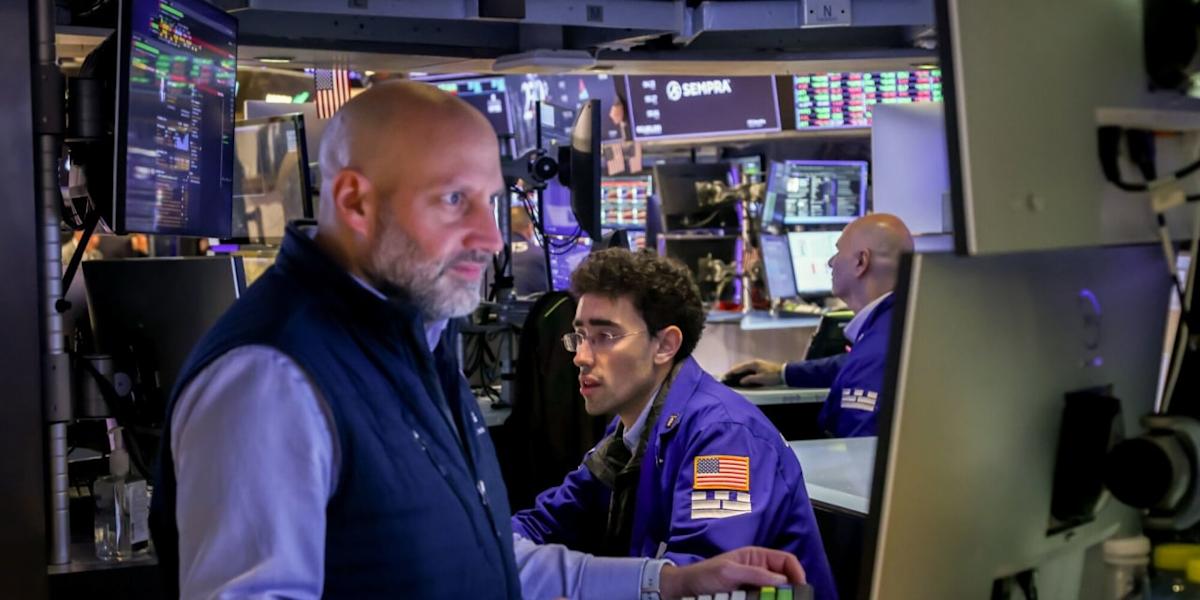Traders work on the floor of the New York Stock Exchange. – Michael Nagle/Bloomberg News
Investors take a lot of comfort from the solidity of Big Tech earnings as worries grow about artificial intelligence overinflating valuations. But those earnings have an ugly underbelly: ever-bigger losses at the generative AI startups that spend big on chips and data centers supplied by the profitable public companies.
Quarterly profits soared at Nvidia, Alphabet, Amazon and Microsoft as AI-related revenue poured in (Meta’s were wiped out by tax). Cash flows are mostly fine, albeit a lot is now going into building new data centers. Some of the money comes from actually selling AI services to businesses, particularly at Alphabet and Microsoft.
But much of the AI-related profits come from being a supplier to, or investor in, the private companies building the large language models behind AI chatbots—and they’re losing money as fast as they can raise it, and plan to keep on doing so for years.
OpenAI and Anthropic are the two largest suppliers of generative AI with their chatbots ChatGPT and Claude, respectively, and founders Sam Altman and Dario Amodei have become tech celebrities.
What’s only starting to become clear is that the companies are also sinkholes for AI losses that are the flip side of chunks of the public-company profits.
Both, along with plenty of other startups, are raising big money and committing to future spending that will require them to raise a lot more. As they spend it on chips and renting cloud computing, sellers of chips and cloud services are the winners and are spending heavily to expand.
For this to continue, two things have to happen. First, the AI developers need to come up with winning products to cover their massive research and computing costs. Second, investors need to stump up enough to finance the losses—which OpenAI alone estimated at more than $150 billion—until then.
It might all work out. The chatbots are near-magical experiences until they make a basic error like thinking 5.11 is bigger than 5.9, a problem even the latest versions still suffer from sometimes.
Fix these, fix the gaping security holes and stop them “hallucinating,” or making up their own facts, and many more businesses and individuals will be willing to pay. New products based on the same underlying technology could become ubiquitous, and eventually transform society.
Story Continues
But even their creators expect to lose money for a long time. OpenAI hopes to turn profitable only in 2030, while Anthropic is targeting 2028.
Meanwhile, the amounts of money being lost are extraordinary.
Microsoft’s share of OpenAI’s loss in the three months to Sept. 30 implies the startup lost more than $12 billion in the quarter. We don’t know for sure since it doesn’t publish its financial statements, but there were no obvious one-off events that would have led to enormous noncash write-downs.
Among companies that have reported so far for the quarter, OpenAI’s loss matches the world’s biggest, that of satellite communications company EchoStar, according to S&P Global Market Intelligence data. But Echostar’s giant loss was due to a noncash charge of $16.5 billion to write off parts of its 5G cellphone network. OpenAI’s was most likely real money.
It’s impossible to quantify how much cash flowed from OpenAI to big tech companies. But OpenAI’s loss in the quarter equates to 65% of the rise in underlying earnings—before interest, tax, depreciation and amortization—of Microsoft, Nvidia, Alphabet, Amazon and Meta together. That ignores Anthropic, from which Amazon recorded a profit of $9.5 billion from its holding in the loss making company in the quarter.
A hefty part of the spending that generated OpenAI’s loss goes to highly paid engineers, but a lot goes into renting Nvidia chips from Microsoft’s cloud service—with much more to come. OpenAI committed to spend $250 billion more on Microsoft’s cloud and has signed a $300 billion deal with Oracle, $22 billion with CoreWeave and $38 billion with Amazon, which is a big investor in rival Anthropic.
This demand for computing capacity is a big part of why data-center construction is in overdrive.
But, to put it mildly, OpenAI doesn’t have the income to cover its costs. It expects revenue of $13 billion this year to more than double to $30 billion next year, then to double again in 2027, according to figures provided to shareholders.
Costs are expected to rise even faster, and losses are predicted to roughly triple to more than $40 billion by 2027. Things don’t come back into balance even in OpenAI’s own forecasts until total computing costs finally level off in 2029, allowing it to scrape into profit in 2030.
These forecasts should be taken with a few server racks loaded with salt. OpenAI has only just settled on a corporate structure, its products are still in development, potential customers are still figuring out how, if at all, to use them, eventual pricing isn’t even at the guesswork stage, the competition is evolving rapidly and, well, nobody really knows how any of this will turn out.
In the frenzy, investors have forgotten the old saying: Revenue is vanity, profits are sanity, cash is reality. If investors stop being so excited about AI, if OpenAI struggles to generate sales, or if fundraising becomes difficult for other reasons such as a recession, investors might switch back from the vanity of revenue to focus on the insane losses.
At that point, the reality that the flow of cash from OpenAI and its rivals is bolstering big tech earnings will become painfully clear.
Write to James Mackintosh at james.mackintosh@wsj.com

